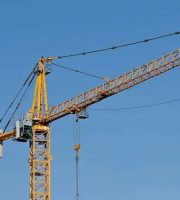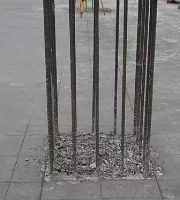The measurement and setting out must be accurate.
4) After hole cleaning, lifting and finishing, use high-pressure air to remove the residual slag in the hole until the wind returning from the orifice feels free of dust, so as to avoid the existence of sediment in the hole.
Steel wire brush shall be used to remove the rust of reinforcement and welded pipe.
Construction process 2.
The diameter of anchor bolt hole shall meet the design requirements (if there is no design requirement, it is advisable to take 3 times of the diameter of anchor bolt, but it shall not be less than one time of the diameter of anchor bolt plus 50mm).
(3) The main purpose of the basic test is to determine the characteristic value of bond strength between anchor solid and rock and soil layer, anchor design parameters and construction technology.
At the same time, the on-site engineer and quality inspector shall detect the hole depth and the deviation of anchor hole, and carry out the next process after meeting the requirements.
During the construction process, special personnel shall be assigned to clean the floor ponding and mortar in the anchor bolt construction area, so as to ensure that the materials are clean and the site is cleaned after the completion of work, so as to ensure the smooth progress of anchor bolt construction.
(2) Before grouting, the hole shall be cleaned to drain the accumulated water in the hole.
6) After placing the rod body and cleaning the hole, insert the anchor rod vertically into the bottom of the hole and firmly place it in the center of the anchor hole.
After reaching the design depth, the drilling shall not be stopped immediately, and the drilling shall be stabilized for 1 ~ 2min to prevent the bottom end from reaching the design anchorage diameter.
The length anchored into the superstructure shall meet the anchorage length requirements of reinforcement.
(5) The following conditions shall be regarded as failure and the loading shall be terminated: the displacement of the anchor head does not converge, the anchor solid is pulled out from the rock and soil layer, or the anchor bolt is pulled out from the anchor solid; The total displacement of anchor head exceeds the design allowable value; The displacement increment generated by the first level load exceeds 2 times of the displacement increment of the previous level load.
During construction, mortar shall be prepared in strict accordance with the mix proportion issued by the laboratory, and the water cement ratio shall be well controlled.
The number of test blocks for slurry strength inspection shall not be less than one group for every 30 anchor bolts, and each group of test blocks shall not be less than 6.
The physical and mechanical properties of anchor bolt materials shall comply with the provisions of current national standards and relevant special standards.
For those who build houses for large families, they can make a living; Those who build dreams build the glory of the country; Heaven should be the upper, and the lower should be the people; Take on this great cause and don’t forget.
(6) Draw load displacement curve, load elastic displacement curve and load plastic displacement curve.
7) After the pressure grouting is placed into the rod body, the pressure grouting is carried out.
The quality supervisor, the supervisor, the owner or the design unit shall also take samples for acceptance test for anchor bolts with quality doubt.
8) Acceptance test of anchor bolt acceptance test of anchor bolt can be carried out after the grouting strength of anchor solid reaches 90% of the design strength.
The cement sand ratio of slurry preparation should be 0.8-1.5, and the water cement ratio should be 0.38-0.5.
(4) The basic test of anchor rod shall adopt the cyclic loading and unloading method.
The positioning deviation of anchor rod shall not be greater than 20mm.
5) According to the nature of the anchoring project, the anchoring position, the scale of the project and other factors, the rod body can be made of ordinary reinforcement with high strength and low relaxation, high-strength finish rolled threaded reinforcement, prestressed steel wire or steel strand.
The inclination of anchor hole shall not be greater than 5%, and the drilling depth exceeding the design length of anchor rod shall not be less than 0.5m.
1、 Stress principle: the tension member of anti floating anchor bolt is anchored at one end in the building bottom plate and the other end in the bearing layer of the foundation.
3.
The total deformation of anchor rod shall meet the design allowable value and shall be basically consistent with the regional experience.
The number of each test anchor rod shall not be less than 3.
Key points of operation 1) Basic test of anchor bolt: refer to appendix C.2 of technical code for building slope engineering gb50330 (1) the geological conditions, anchor bolt materials and construction technology of basic test of anchor bolt shall be consistent with the engineering anchor bolt.
Equipment configuration 4.
The anchor bolt hole is drilled with the pipe, and the high-pressure air generated by the air compressor is used for slag removal.
3) when the drilling rig is in place, it must be firmly fixed to ensure the levelness of the drilling rig frame and the verticality of the vertical shaft.
(2) During the basic test, the maximum test load should not exceed 0.9 times of the standard value of the bearing capacity of the anchor rod body.
(3) The grouting pipe should be put into the hole together with the anchor bolt, and the distance from the end of the grouting pipe to the hole bottom should be 100mm..
2) Measure and set out the anchor bolt according to the control point and anchor bolt layout plan, and mark the setting out point of anchor hole.
The number of anchor bolts for acceptance test shall be 5% of the total number of anchor bolts of each type, and shall not be less than 5.
The grouting pipe is inserted 30cm away from the hole bottom, the slurry is poured inward from the grouting pipe, and the gas is directly discharged.
The purpose of anchor bolt acceptance test is to check whether the construction quality meets the design requirements.
Quality standard 1) control standard 2) assurance measures: (1) select drilling machinery considering factors such as stratum type, drilling conditions, anchorage type, anchor bolt length, construction site environment, topographic conditions, economy and construction speed.
Grouting completion standard: until the discharged slurry concentration is the same as the injected slurry concentration and there are no bubbles.
Anchor bolts for acceptance test shall be sampled randomly.
The blanking length of anchor bolt is the drilling length + the length anchored into the superstructure.
If the anchor rod fails to pass the acceptance, it shall be re sampled according to 30% of the total number of anchor rods; If there are any more bolts that are unqualified, they shall be inspected in full.
The stress process is first to transfer the uplift force to the grouting body through the action between the anchor reinforcement and the grouting body; Then, the force received by the grouting body is transmitted to the surrounding stable soil through the friction between the grouting body and the surrounding soil layer, so as to form an anti floating anchor rod with certain pull-out capacity and play the anti floating role of the anti floating anchor rod.
The reverse grouting at the hole bottom is adopted.
2、 Construction process of anti floating anchor bolt 1.
It is required to make records during the measurement and setting out process and check to ensure the accuracy of the hole position.
Pay attention to the liquid level during grouting, and make up grouting if there is a drop.
Add construction projects to the above points.
The grouting material is cement mortar or pure water slurry, and expansion agent and early strength agent can be added according to the actual situation.
The mud content of sand shall not be greater than 3% by weight, and the content of mica, organic matter, sulfide, sulfate and other harmful substances in sand shall not be greater than 1% by weight.
Ordinary portland cement should be used for cement.


